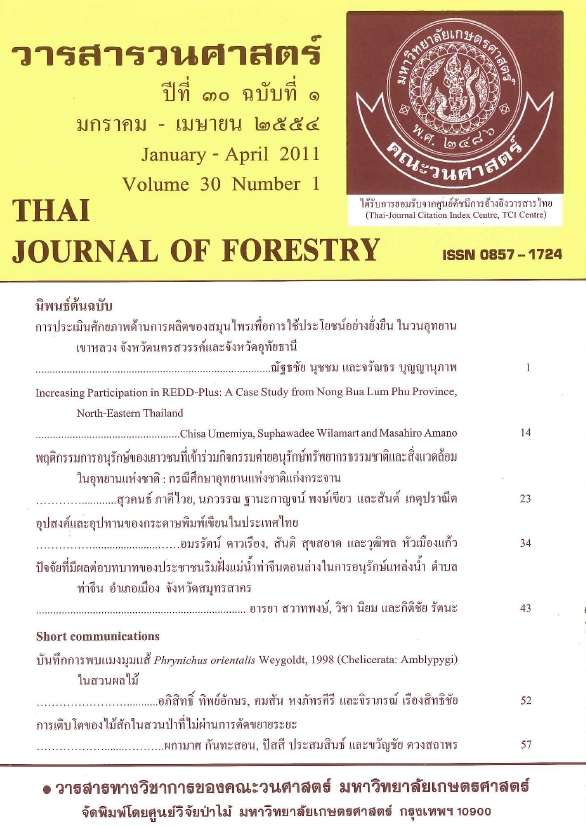การประเมินศักยภาพด้านการผลิตของสมุนไพรเพื่อการใช้ประโยชน์อย่างยั่งยืน ในวนอุทยานเขาหลวง จังหวัดนครสวรรค์และจังหวัดอุทัยธานี
Main Article Content
บทคัดย่อ
การศึกษาครั้งนี้มีจุดมุ่งหมายเพื่อประเมินศักยภาพด้านการผลิตของสมุนไพรในพื้นที่ป่าธรรมชาติของวนอุทยานเขาหลวง พร้อมทั้งศึกษาแนวทางการอนุรักษ์และใช้ประโยชน์จากพืชสมุนไพรอย่างยั่งยืน ด้วยการวางแปลงตัวอย่างสำรวจชนิดของพันธุ์พืชและเก็บแบบสอบถามจากประชากรตัวอย่างที่เป็นผู้ใช้ประโยชน์สมุนไพรทั้งทางตรงและทางอ้อม ผลการศึกษาพบว่า สังคมพืชและสมุนไพรในวนอุทยานเขาหลวงสามารถจำแนกได้ 3 ประเภท ได้แก่ สังคมป่าดิบแล้ง สังคมป่าเบญจพรรณ และสังคมป่าเต็งรัง จากการสำรวจชนิดของพันธุ์พืชสมุนไพรในสังคมป่าไม้ทั้ง 3 ประเภท พบทั้งหมด 45 ชนิด ซึ่งพบพืชสมุนไพรในป่าดิบแล้ง 16 ชนิด ป่าเบญจพรรณ 20 ชนิด และป่าเต็งรัง 9 ชนิด โดยกำลังควายถึก (Dracaena robusta Ridl.) บัวสันโดษ (Nervilia calcicola Kerr) และหัวยาข้าวเย็น (Smilax glabra Roxb.) เป็นพืชสมุนไพรที่มีค่าดัชนีความสำคัญทางนิเวศวิทยาสูงสุดในป่าดิบแล้ง ป่าเบญจพรรณ และป่าเต็งรัง ตามลำดับ สำหรับศักยภาพด้านการผลิตของสมุนไพรในวนอุทยานเขาหลวงของสังคมป่าทั้ง 3 ประเภท ณ สภาพในปัจจุบัน มีค่ารวมเท่ากับ 1,459.32 ตัน โดยพบว่ารางแดง (Ventilago denticulata Willd.) เป็นพืชสมุนไพรในสังคมป่าดิบแล้งที่มีกำลังผลิตสูงที่สุด เท่ากับ 531.75 ตันกิโลกรัม เถาวัลย์เหล็ก (Ventilago calyculata Tul.) เป็นพืชสมุนไพรในสังคมป่าเบญจพรรณที่มีกำลังผลิตสูงสุด เท่ากับ 169.02 ตัน หนอนตายหยาก (Stemona tuberosa Lour.) เป็นพืชสมุนไพรในป่าเต็งรังที่มีกำลังผลิตสูงที่สุด เท่ากับ 63.22 ตัน ราษฎรท้องถิ่นที่ใช้ประโยชน์จากสมุนไพรมีความเห็นว่าความอุดมสมบูรณ์ของสมุนไพรลดลงจากอดีต โดยไฟป่าส่งผลต่อการทำลายทรัพยากรสมุนไพรมากที่สุด นอกจากนี้ชุมชนในท้องถิ่นยังให้ความสำคัญกับการอนุรักษ์ทรัพยากรสมุนไพรให้เป็นแหล่งเรียนรู้ทางธรรมชาติและการท่องเที่ยวเชิงนิเวศมากที่สุด และไม่เห็นด้วยที่จะห้ามราษฎรเข้าไปเก็บหาสมุนไพรในป่าโดยเด็ดขาด แต่ต้องกำหนดมาตรการที่เหมาะสมในการเข้าไปเก็บหาสมุนไพรเพื่อใช้ประโยชน์ได้ พร้อมทั้งส่งเสริมการมีส่วนร่วมของราษฎรในท้องถิ่นกับหน่วยงานที่เกี่ยวข้องในการกำหนดมาตรการด้านการอนุรักษ์และใช้ประโยชน์สมุนไพรในวนอุทยานเขาหลวงอย่างยั่งยืน
คำสำคัญ: วนอุทยานเขาหลวง สมุนไพร ศักยภาพด้านการผลิตของสมุนไพร
Downloads
Article Details

อนุญาตภายใต้เงื่อนไข Creative Commons Attribution-NonCommercial-NoDerivatives 4.0 International License.
ข้าพเจ้าและผู้เขียนร่วม (ถ้ามี) ขอรับรองว่า ต้นฉบับที่เสนอมานี้ยังไม่เคยได้รับการตีพิมพ์และไม่ได้อยู่ในระหว่างกระบวนการพิจารณาตีพิมพ์ลงในวารสารหรือสิ่งตีพิมพ์อื่นใด ข้าพเจ้าและผู้เขียนร่วม (ถ้ามี) ยอมรับหลักเกณฑ์และเงื่อนไขการพิจารณาต้นฉบับ ทั้งยินยอมให้กองบรรณาธิการมีสิทธิ์พิจารณาและตรวจแก้ต้นฉบับได้ตามที่เห็นสมควร พร้อมนี้ขอมอบลิขสิทธิ์ผลงานที่ได้รับการตีพิมพ์ให้แก่วารสารวนศาสตร์ คณะวนศาสตร์ มหาวิทยาลัยเกษตรศาสตร์ กรณีมีการฟ้องร้องเรื่องการละเมิดลิขสิทธิ์เกี่ยวกับภาพ กราฟ ข้อความส่วนใดส่วนหนึ่ง หรือ ข้อคิดเห็นที่ปรากฏในผลงาน ให้เป็นความรับผิดชอบของข้าพเจ้าและผู้เขียนร่วม (ถ้ามี) แต่เพียงฝ่ายเดียว และหากข้าพเจ้าและผู้เขียนร่วม (ถ้ามี) ประสงค์ถอนบทความในระหว่างกระบวนการพิจารณาของทางวารสาร ข้าพเจ้าและผู้เขียนร่วม (ถ้ามี) ยินดีรับผิดชอบค่าใช้จ่ายทั้งหมดที่เกิดขึ้นในกระบวนการพิจารณาบทความนั้น”


